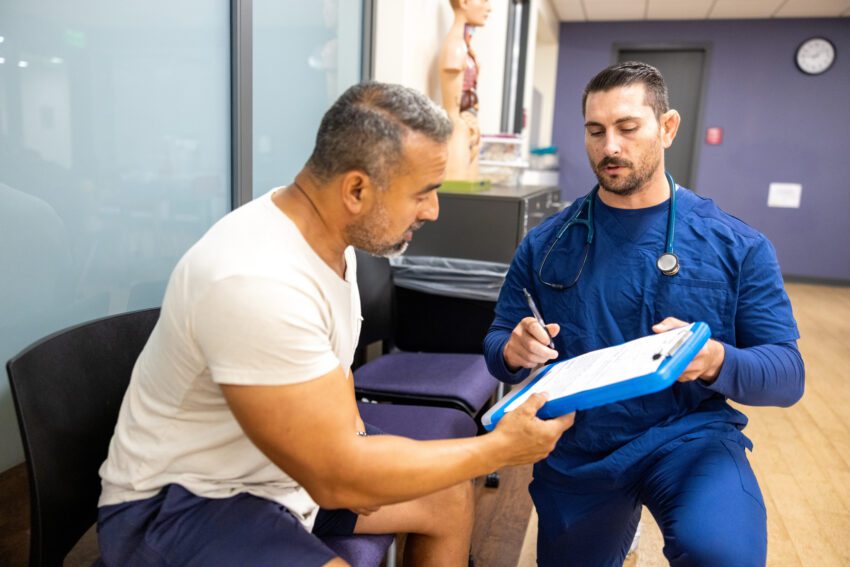Background
Despite the Food and Drug Administration (FDA) approval of artificial discs, most patients did not have access to the treatment option known as arthroplasty (or disc replacement surgery) until insurance companies provided authorization of the procedure and covered the cost. It has been a long journey for arthroplasty reimbursement, and more is left to achieve.
Healthcare coverage in the United States is a complex topic. This article will focus on two types of insurers. The first is Medicare, which is a federal health insurance mainly for people 65 years or older. The second is the broad category of private health insurance, which is most often provided as an employment benefit and is offered by a variety of companies (Aetna, Cigna, etc.) with a variety of plans (HMO, PPO, POS). Coverage varies based on these plans, and Medicare often sets the precedent for what the private insurers cover.
In general, the path to bringing a new device (in this case, artificial disc) from a patent to the patient is:
- Research and Development: The device is designed based on prototyping.
- Regulatory approval: The FDA requires approval of new devices, such as artificial discs, based on clinical trial results.
- Clinical trials: Rigorous clinical trials must demonstrate safety & efficacy to gain FDA approval.
- Manufacturing: Device manufacturers begin production.
- Market approval: Once regulatory approval is obtained, the device can be marketed to healthcare providers & facilities.
- Training: Healthcare professionals are trained to use the device safely.
- Insurance coverage: Manufacturers & healthcare providers work with insurance companies to develop reimbursement strategies, which includes coding & billing.
- Patient access: Organizations like the National Spine Health Foundation educate patients on treatment options & spine surgeons discuss new treatment options with patients who qualify.
- Monitoring: Manufacturers & healthcare providers monitor performance and safety in real-world settings.
It is important to note that several artificial disc implants have gone through that lengthy process, separately for cervical (neck) and lumbar (low back) implants, for the treatment of 1- and 2-levels of disc disease, and were granted FDA approval.
Approval Limitations
Going back to the clinical trials, it must be highlighted that the conditions under which the artificial discs are tested are very strict, giving clear results, which helps with the FDA approval process. FDA approval is based on these specific conditions, but this does not mean that those strict conditions are the only conditions under which the device will work. In the case of artificial discs, there are many uses that extend beyond what was tested in the clinical trials, and it is up to the expertise of the spine surgeon to make treatment recommendations based on each patient’s pathology. However, insurance coverage will vary for these “off label” uses.
For example, hybrid surgery in the neck combines implanting an artificial disc at one cervical disc level and a fusion at another level. Hybrid surgeries were not studied in the original FDA clinical trials, and thus are not included in the specific FDA labeling or in the insurance coverage of most plans. There have been many non-FDA studies demonstrating the benefits of hybrid surgery, yet there are only 2-3 private insurers that cover hybrid surgery in the neck.
Hard-Fought Battles
Lumbar arthroplasty coverage has been an unusually hard-fought battle to get to the point where 90% of private insurers cover 1-level surgery and about 40% cover 2-level surgery today. The history of this challenge started in the early 2000’s with skeptics requesting that Medicare conduct a national analysis of the first lumbar artificial disc. They did this knowing that the clinical trial was limited to patients 18-60 years old, which is below the typical Medicare-aged population of 65 years. Without data to prove clinical efficacy for this age group, Medicare issued a national non-coverage determination blocking coverage for their insured. In addition, this determination by Medicare led private insurers to quickly follow suit, essentially closing the door on general coverage for all age groups of this modern technology.
Over time, industry leaders, dedicated spine surgeons, and many patients have fought insurance denials by peer-to-peer conversations with insurers, working through the external appeals process, and ultimately by class action lawsuits against insurers for denying access to care. Slowly coverage has opened but remains limited to the literal interpretation of the strict criteria included in the original clinical trials.
Understanding the Evidence
Clinical experience with cervical and lumbar arthroplasty has been overwhelmingly positive:
- Most patients with follow-ups of 15-25 years have not required any significant long-term interventions for device failure or symptomatic adjacent level disease (issues at neighboring discs).
- Many long-term studies have demonstrated that patients who received artificial discs had similar or improved outcomes and a significant decrease in additional surgery compared to patients randomly assigned to receive the fusion alternative.
- Consistent data at 5-years show that cervical arthroplasty patients had 3-5 times LESS reoperations than matched fusion patients, and lumbar arthroplasty patients have only one-third of worsening adjacent levels as fusion patients.
- A 5-year meta-analysis of four multicenter studies showed superiority in patient-reported disability improvement, reoperation rate, pain relief, and patient satisfaction of arthroplasty over fusion.
- Several health economics papers have demonstrated reduced costs to the insurance carrier for cervical arthroplasty than for cervical fusion (ACDF). In the lumbar spine, implant costs per segment are less with lumbar arthroplasty than with any fusion surgery, which may include implants, bone graft, and more.

Unfortunately, although annual reviews of insurance company medical policies are supposed to be based on objective analysis of published data, they do not routinely result in a change to their coverage policies, even though both cervical and lumbar arthroplasty have been more intensively studied than any other implant used in the human body.
What Can Be Done?
Arthroplasty surgeons spend quite a bit of time on the phone with the insurance companies of their patients who are being denied access to arthroplasty. These “peer-to-peer” calls are used to justify denials and are generally not a discussion between a surgeon and an informed peer, but may result in an invitation to request another level of review. “Additional review” notifications on the eve of a previously approved and scheduled surgery are also occurring with more regularity, as well as denials of payment for previously-approved surgical procedures.
The clinician’s best weapon is self-education regarding the strong published literature, including real-world evidence of expanded use based on decades of clinical experience beyond the strict FDA indications and exclusions. This information should be discussed with the insurance company’s additional Peer Reviewer who will hopefully be a reasonable clinician willing to grant an exception to the initial denial based on a more in-depth clinical discussion.
Going forward, Big Data should ultimately come to the attention of insurers, who will recognize the lower complication and reoperation rates with arthroplasty (the major drivers of postoperative health care costs) and then soften authorization criteria. Auditing these complication and reoperation rates will potentially identify surgeons who should be preferred providers for this technology, a model that has worked well with procedures such as cardiac surgery and joint replacements, like hips and knees.
Surgeons need to demand that their professional organizations (ISASS, AANS, AAOS) remain actively involved in the fight. This will help to ensure that patients have access to care utilizing appropriate FDA-approved technologies deemed best for a specific patient’s medical condition by a trained and qualified spine specialist. The National Spine Health Foundation represents the patient voice and is the only patient advocacy organization working with professional societies to improve access to care by creating materials such as this journal.
The science is there. The clinical experience is there. The coverage is improving for arthroplasty, but the devil is in the details. Public education and patient demand will ultimately tip the scale towards an easier path to more universal patient access to this motion-preserving technology.



